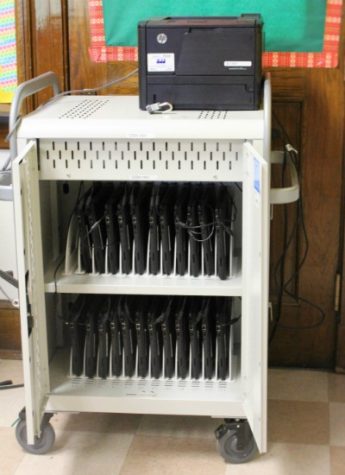A look at technology in Amherst and Springfield high schools
November 3, 2016
Jose Perez, a 2015 graduate of Springfield’s High School of Commerce, is now a first generation college freshman at Holyoke Community College. Sitting in a lecture hall surrounded by students on laptops, Perez writes his research paper on a mobile Microsoft Word app downloaded to his iPhone 6. Without a laptop, sound recorder or Wi-Fi at home, he conducts interviews with a pen and paper. His only computer class in high school taught him how to fill out job applications — not how to navigate Microsoft PowerPoint.
“Even if I had the money to purchase a laptop, I wouldn’t know how to use it. I wouldn’t even know the questions to ask. Now I’m expected to just know” Perez said.
The Department of Elementary and Secondary Education classifies Commerce as a level 4 school due to stagnant underperformance on Massachusetts Comprehensive Assessment System (MCAS) standardized tests. If Perez lived 25 miles north and attended Amherst Regional High School, he’d be in a whole new world of technology. He is a product of the global digital divide in education.
This issue is impacting student opportunities as they enter a workforce dominated by technology. Lower-income, minority school districts don’t have the resources to prepare students for an automated world.
“The jobs our students are going to have ten years from now aren’t invented yet. They’re competing against robots and they need to be ready for that,” says Haldan Pflueger-Smith, an algebra teacher and digital learning coordinator in Springfield.
U.S. News’ Best High School Rankings placed Amherst Regional High School at 56 out of 353 high schools statewide. Here, students decide between 19 different computer and technology courses ranging from computer science, to broadcast journalism, to mechanical and electrical engineering. Students can earn certificates in radio and TV broadcasting and engineering.
In the Amherst-Pelham district, technology begins at the elementary level. Elementary students practice robotics with robotic Lego kits. From fourth grade to sixth grade, each classroom has Chromebook laptop carts for student use. Seventh graders even have one-to-one laptops.
All high school departments have a laptop cart for teachers to check out and access to several computer labs.
According to Jerry Champagne, director of Information Systems for the Amherst-Pelham Schools, students are technologically proficient by high school.
“It then becomes a task of teaching them how to use it appropriately and to their advantage,” Champagne said.
Back in Springfield, things are far different. Despite having 90 teachers, there are only 53 carts of 24 laptops at Commerce. There are a few computer labs used for credit recovery classes. Through a software called Edgenuity, students re-take classes they failed.

The only computer science course offered to sophomores is a prerequisite for a newly built International Baccalaureate, or IB, career pathway in information technology security.
For students not enrolled in this advanced program, there are no computer classes offered.
“Many of my students have never been taught basic Microsoft Office programs, which makes it even harder to integrate technology into my lesson plans,” said English teacher Brian Damboise.
Amherst students do much of their learning online, through platforms like Moodle. With training sessions from Information Services, Amherst teachers transition to Google Classroom. This virtual learning program helps teachers communicate with students, grade assignments and issue homework. The assignments link with Google Docs so that students can submit their work and receive feedback online.
Similarly, few courses at Commerce use Brightspace, an online learning and training system. But many Commerce students have no way to access the site at home.
Senior Tonyawshaw Spencer doesn’t own a computer and has to stay after school or find a library on the bus route to do her homework.
“I know a lot of people that have to do the same thing,” said Spencer.
Computer technology in Amherst depends on student enrollment and consistent budget cuts. Champagne credits the Amherst School Committee in making these classes possible.
“They made a commitment years ago to financially supporting technology in these schools,” Champagne said.
At Springfield’s Commerce High, students and teachers are fighting for that support. A new team of 15 administrators and teachers work to integrate computer science into all grade levels. They also advocate the district for one-to-one laptops.
Though budget plays a major role, Plueger-Smith, Springfield’s digital learning coordinator, believes the problem is far more complex. Often times Common Core requirements assume students have skills they never acquired and integrating technology in the classroom overwhelms teachers.
Plueger-Smith’s current solution for the digital divide lies in the Elementary School curriculum. By introducing technology early, he says “they are intermediate learners by middle school and advanced by the time they reach us.”
But these solutions lack the necessary funding to make change.
According to the Massachusetts Budget and Policy Center, the Amherst-Pelham district belongs to the middle wealth quintile of the state, ranging between 40 and 60 percent. Springfield is among the lowest wealth districts, between 0 and 20 percent.
The foundation budget is the amount of funding the state believes is necessary for quality education within a district. The formula has yet to factor in special education or health insurance costs. The annual aid provided is too low.
The Amherst-Pelham district spends $261 on technology though the foundation budget is set at $593. The state calculates Springfield needs $506 for proper materials and technology. Without the wealth Amherst has to compensate for these programs, only $134 is actually spent on technology in Springfield schools.
Email Devin at [email protected] or follow her on Twitter @devinfiona.
